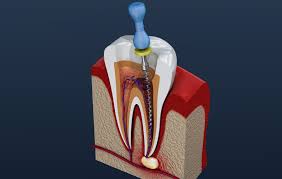
Root canal treatment is a dental procedure designed to treat infection at the center of a tooth, commonly referred to as the root canal system. This treatment is essential for saving a tooth that would otherwise need to be extracted due to severe decay or infection. Understanding the step-by-step process of root canal treatment can help alleviate any anxiety and provide clarity on what to expect during the procedure. This article will delve into the detailed steps involved in root canal treatment, highlighting its importance and how dental filling plays a crucial role in the process.
What is Root Canal Treatment?
Root canal treatment, also known as endodontic therapy, is a procedure aimed at removing infected or damaged tissue from within a tooth. The root canal system consists of the dental pulp, a soft tissue containing nerves and blood vessels. When this pulp becomes infected due to decay, cracks, or trauma, it can cause severe pain and lead to abscess formation if left untreated. Root canal treatment eliminates the infection and preserves the natural tooth.
Step-by-Step Process of Root Canal Treatment
1. Initial Consultation and Diagnosis
The first step in the root canal treatment process is an initial consultation with your dentist or endodontist (a specialist in root canal therapy). During this visit, the dentist will:
- Take a detailed medical history and discuss any symptoms you’re experiencing, such as toothache, sensitivity, or swelling.
- Perform a thorough examination of the affected tooth, which may include taking X-rays to assess the extent of the infection and the shape of the root canals.
- Confirm the diagnosis and determine if root canal treatment is necessary.
2. Preparation and Anesthesia
Once the need for root canal treatment is confirmed, the dentist will prepare for the procedure:
- Local anesthesia is administered to numb the affected tooth and surrounding area, ensuring you remain comfortable and pain-free throughout the treatment.
- A rubber dam is placed around the tooth to keep it dry and free from saliva during the procedure. This barrier also prevents any debris from entering your mouth.
3. Accessing the Root Canal
With the tooth numbed and isolated, the dentist begins the procedure:
- An access hole is drilled into the crown of the tooth to reach the infected pulp chamber and root canals. This opening allows the dentist to remove the damaged tissue and clean the canals thoroughly.
4. Cleaning and Shaping the Canals
Cleaning and shaping the root canals are critical steps in the root canal treatment process:
- Using specialized instruments called endodontic files, the dentist carefully removes the infected pulp and any debris from the root canals. These files come in various sizes to ensure thorough cleaning.
- The dentist then shapes the canals to prepare them for filling. This step is crucial for ensuring the filling material adheres properly and prevents future infection.
5. Disinfecting the Canals
After the canals are cleaned and shaped, they must be disinfected to eliminate any remaining bacteria:
- The dentist uses an antimicrobial solution to irrigate the canals, removing any lingering bacteria and preventing reinfection.
- This step ensures the root canals are sterile before sealing them.
6. Filling the Canals
Once the canals are thoroughly cleaned and disinfected, the next step is to fill them to prevent future infection:
- The dentist uses a biocompatible material called gutta-percha to fill the root canals. Gutta-percha is a rubber-like substance that seals the canals effectively.
- The material is inserted into the canals and compacted using special instruments to ensure a tight seal.
- In some cases, the dentist may place a temporary filling in the access hole until a permanent restoration can be completed.
7. Sealing the Tooth
The final step in the root canal treatment process is sealing the tooth to restore its function and appearance:
- A dental filling is placed in the access hole to seal it permanently. This filling can be made from various materials, including composite resin or amalgam, depending on the location of the tooth and your dentist’s recommendation.
- In many cases, a crown is recommended to protect the treated tooth and restore its strength. The crown covers the entire tooth, providing durability and preventing future damage.
8. Post-Treatment Care
After the root canal treatment is completed, proper post-treatment care is essential for ensuring the tooth heals correctly:
- The dentist will provide instructions on how to care for the treated tooth, including recommendations for pain management and oral hygiene practices.
- It’s normal to experience some mild discomfort or sensitivity for a few days following the procedure. Over-the-counter pain relievers can help alleviate these symptoms.
- Schedule follow-up appointments with your dentist to monitor the healing process and address any concerns.
Importance of Dental Filling in Root Canal Treatment
Dental filling plays a crucial role in the success of root canal treatment. After the infected pulp is removed, the tooth becomes hollow and vulnerable to fractures. Filling the tooth with gutta-percha and placing a dental filling in the access hole restores the tooth’s integrity and prevents bacteria from re-entering the root canals. This sealing process is vital for the long-term success of the treatment and the preservation of the natural tooth.
Conclusion
Root canal treatment is a highly effective procedure for saving a tooth with severe decay or infection. Understanding the step-by-step process can help demystify the treatment and alleviate any fears you may have. From the initial consultation and diagnosis to the final sealing and post-treatment care, each step is designed to eliminate infection, restore the tooth’s function, and prevent future complications. Dental filling plays an integral role in this process, ensuring the treated tooth remains strong and healthy for years to come. If you’re experiencing symptoms of a tooth infection, consult your dentist to determine if root canal treatment is the right solution for you.






